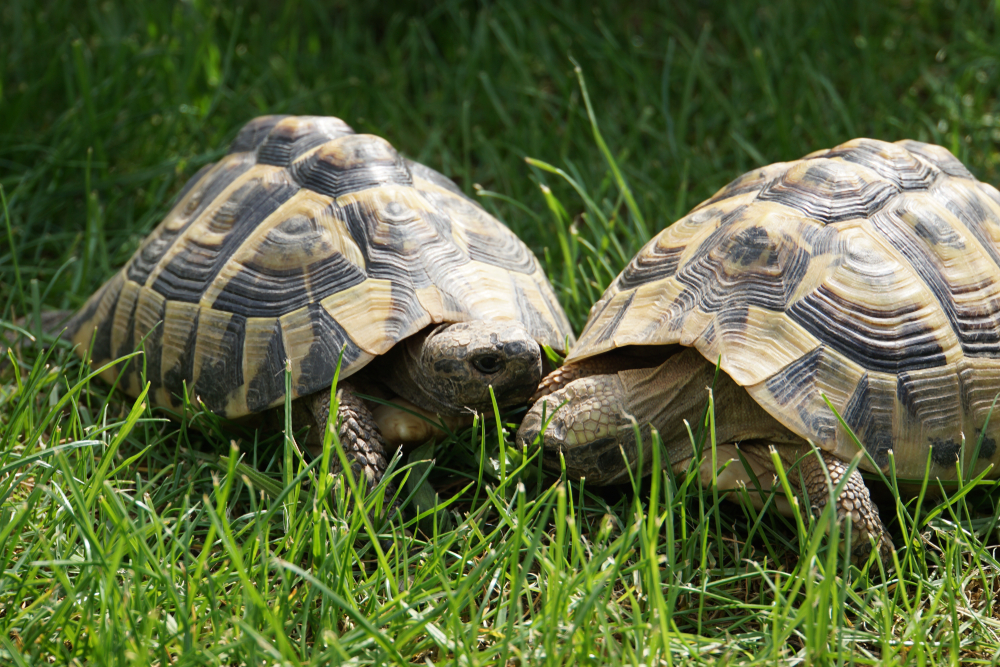Feeding your Hermann’s tortoise (Testudo hermanni) the right diet is essential for their overall health and longevity. These fascinating reptiles require a balanced and varied diet to thrive in captivity. Understanding their specific nutritional needs helps prevent common health issues and ensures a happy, healthy tortoise. This article provides an in-depth look at what to feed Hermann’s tortoise, covering their dietary requirements, suitable food options, and practical tips for creating a balanced meal plan.
Understanding Hermann’s Tortoise Nutritional Needs
Hermann’s tortoises are herbivores with specific dietary requirements that reflect their natural habitat. Here’s a detailed breakdown of their nutritional needs:
- High-Fiber Diet: Hermann’s tortoises need a high-fiber diet to support healthy digestion and prevent obesity. In their natural environment, they graze on various grasses and plants. To replicate this, offer a variety of fibrous grasses and leafy greens. High-fiber foods help prevent digestive issues and promote overall well-being.
- Leafy Greens: Provide a range of leafy greens such as dandelion leaves, clover, and collard greens. These greens are rich in vitamins and minerals essential for your tortoise’s health. Avoid greens that are high in oxalates or goitrogens, such as spinach and kale, as they can interfere with calcium absorption and lead to health problems.
- Vegetables and Flowers: Supplement their diet with a small amount of vegetables and edible flowers. Suitable vegetables include squash, bell peppers, and carrots. Edible flowers like hibiscus petals and marigolds can be offered occasionally. These additions provide variety and essential nutrients but should not constitute the majority of their diet.
- Calcium and Vitamin D3: Calcium is crucial for shell health and bone development. Provide a calcium supplement regularly to ensure your tortoise gets enough of this vital nutrient. Vitamin D3 is also important for calcium absorption, so ensure your tortoise has access to UVB lighting, which helps in the synthesis of vitamin D3.
- Hydration: Fresh water should always be available for your tortoise. Additionally, soaking your tortoise in a shallow dish of water a few times a week can help maintain hydration and support digestion. This practice is especially beneficial if you notice signs of dehydration or if your tortoise is not drinking enough water on its own.
Creating a Balanced Diet Plan
Developing a balanced diet plan for your Hermann’s tortoise involves understanding their preferences and nutritional needs. Here’s how to create an effective feeding routine:
- Daily Diet: Base their diet on a mix of high-fiber grasses and leafy greens. Offer fresh food daily to ensure they receive a balanced intake of nutrients. Aim for a variety of greens and grasses to prevent dietary deficiencies and provide essential vitamins and minerals.
- Supplemental Foods: Introduce occasional treats such as fruits and vegetables, but keep these to a minimum. Fruits should be offered in small quantities due to their high sugar content, which can lead to health issues if consumed in excess. Vegetables like squash and bell peppers can be given occasionally to add variety.
- Avoiding Common Mistakes: Steer clear of feeding Hermann’s tortoise high-protein foods, such as animal products or commercial tortoise pellets not specifically formulated for their species. These can lead to metabolic disorders and other health problems. Also, avoid giving them human food or processed foods that are unsuitable for their diet.
- Monitoring Health: Regularly observe your tortoise’s eating habits and body condition. Changes in weight, appetite, or stool consistency can indicate dietary imbalances or health issues. Adjust their diet accordingly and consult a reptile veterinarian if you notice any concerning symptoms.
Additional Feeding Tips
- Variety and Freshness: Ensure that all food offered is fresh and free from pesticides. A varied diet is key to preventing nutritional deficiencies and keeping your tortoise engaged with their food.
- Food Preparation: Wash all fruits and vegetables thoroughly before offering them to your tortoise. Chop or shred larger pieces of food to make them easier for your tortoise to consume.
- Feeding Schedule: Establish a consistent feeding schedule to help regulate your tortoise’s appetite and digestion. Feed them at the same time each day and monitor how much they eat to ensure they are consuming an adequate amount of food.
- Avoiding Overfeeding: Be mindful of portion sizes to prevent overfeeding. Excessive food intake can lead to obesity and other health issues. Monitor your tortoise’s weight and adjust their portions as needed.
Conclusion
Feeding your Hermann’s tortoise a balanced and nutritious diet is essential for their health and well-being. By providing a high-fiber diet, supplementing with calcium and vitamin D3, and avoiding common dietary pitfalls, you can ensure your tortoise thrives and enjoys a long, healthy life. Regular monitoring and adjustments to their diet, along with consultation with a reptile veterinarian, will help you provide the best care for your Hermann’s tortoise.This resource offers valuable information to support your tortoise’s health and enhance your experience as a tortoise owner.
By understanding and implementing these dietary guidelines, you’ll be well-equipped to support your Hermann’s tortoise in leading a vibrant and fulfilling life.

“Proud thinker. Tv fanatic. Communicator. Evil student. Food junkie. Passionate coffee geek. Award-winning alcohol advocate.”


